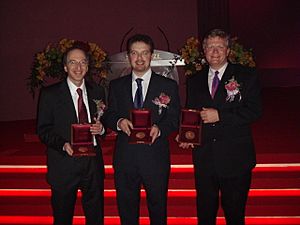Adam Riess facts for kids
Quick facts for kids
Adam Riess
|
|
|---|---|

Riess in 2011
|
|
| Born |
Adam Guy Riess
December 16, 1969 Washington, D.C., U.S.
|
| Alma mater | Massachusetts Institute of Technology (BS) Harvard University (PhD) |
| Known for | Accelerating universe / dark energy, Hubble constant |
| Spouse(s) | Nancy Joy Schondorf (m. 1998) |
| Awards | Robert J. Trumpler Award (1999) Helen B. Warner Prize for Astronomy (2002) Sackler Prize for Physics (2004) Shaw Prize in Astronomy (2006) Nobel Prize in Physics (2011) Albert Einstein Medal (2011) Breakthrough Prize in Fundamental Physics (2015) |
| Scientific career | |
| Fields | Physics |
| Institutions | |
| Thesis | Type Ia Supernova Multicolor Light Curve Shapes (1996) |
| Doctoral advisor | Robert Kirshner, William H. Press |
Adam Guy Riess (born December 16, 1969) is an American astrophysicist. He is a professor at Johns Hopkins University and the Space Telescope Science Institute. He is well-known for his research using exploding stars called supernovae to study the universe.
Riess shared the 2006 Shaw Prize in Astronomy and the 2011 Nobel Prize in Physics. He won these awards with Saul Perlmutter and Brian Schmidt. They received the prizes for finding evidence that the expansion of the universe is speeding up.
Riess is also part of an important scientific discussion. This discussion is about the "Hubble tension." It's a puzzle where measurements of the universe's expansion rate don't quite match up. This has led scientists to ask if our current understanding of the universe needs to be updated.
Contents
Family Life
Adam Riess was born in Washington, D.C.. He grew up in Warren Township, New Jersey. He has two sisters, Gail Saltz and Holly Hagerman.
His father, Michael Riess, owned a company that distributed frozen foods. His mother, Doris Riess, worked as a clinical psychologist.
Riess married Nancy Joy Schondorf in 1998. They have two children, Noah and Gabrielle.
Education and Early Career
Riess went to Watchung Hills Regional High School and graduated in 1988. He also attended a special science program in New Jersey in 1987.
He then studied at The Massachusetts Institute of Technology (MIT). He graduated from MIT in 1992. Riess earned his PhD from Harvard University in 1996. For his PhD, he studied over twenty new Type Ia supernovae. He also developed a way to use these supernovae to measure distances in space more accurately. His PhD work was supervised by Robert Kirshner and William H. Press. It won the Robert J. Trumpler Award in 1999.
Discovering the Accelerating Universe
After his PhD, Riess was a researcher at the University of California, Berkeley, from 1996 to 1999. During this time, he published his first important paper about the universe speeding up. In 1999, he moved to the Space Telescope Science Institute. He also started working at Johns Hopkins University in 2006.
In 1998, Riess helped lead a group called the High-z Supernova Search Team. This team found the first evidence that the universe's expansion is speeding up. They did this by watching Type Ia supernovae. Their observations were surprising because scientists thought the universe's expansion was slowing down. But by looking at the light from these very old supernovae, they saw that the expansion was actually getting faster.
Another team, the Supernova Cosmology Project, led by Saul Perlmutter, found the same result around the same time. Both teams' findings confirmed each other. This led to the acceptance of the accelerating universe idea. It also started new research to understand what makes the universe speed up, like the idea of dark energy.
The discovery of the accelerating universe was called the 'Breakthrough of the Year' by Science magazine in 1998. Riess, along with Schmidt and Perlmutter, received the 2011 Nobel Prize in Physics for this amazing work.
From 2002 to 2007, Riess led another team called the Higher-Z SN Team. They used the Hubble Space Telescope to find many Type Ia supernovae. They showed that the universe's expansion was slowing down before it started speeding up.
Riess is also known for trying to measure the current rate of the universe's expansion, called the Hubble constant. Since 2005, he has led the SH0ES Team. Their measurements are very precise. However, they show a small difference compared to predictions from models of the early universe. This difference is known as the "Hubble tension" in cosmology.
Awards and Recognitions

Riess has received many awards for his important discoveries:
- In 1999, he received the Astronomical Society of the Pacific's Robert J. Trumpler Award.
- In 2001, he won Harvard University's Bok Prize.
- In 2003, he won the American Astronomical Society's Helen B. Warner Prize.
- In 2004, he received the Raymond and Beverly Sackler Prize in Physics.
- In 2006, he shared the $1 million Shaw Prize in Astronomy with Saul Perlmutter and Brian P. Schmidt.
- In 2007, Riess and all members of the High-Z Team shared the Gruber Cosmology Prize. They shared this $500,000 award with the Supernova Cosmology Project.
- In 2008, he received a MacArthur "Genius" Grant.
- In 2009, he was elected to the National Academy of Sciences.
- In 2011, he was awarded the 2011 Nobel Prize in Physics with Perlmutter and Schmidt.
- In 2012, Riess received the Golden Plate Award from the American Academy of Achievement.
- In 2015, Riess, Brian P. Schmidt, and the High-Z Supernova Search Team shared the Breakthrough Prize in Fundamental Physics.
- In 2020, Riess became a fellow of the American Astronomical Society.
See also
 In Spanish: Adam Riess para niños
In Spanish: Adam Riess para niños
- Cosmological constant
- Dark energy
- List of Jewish Nobel laureates

